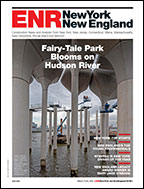Working in New York, though, does not come without challenges. In the metropolitan market, designers are always trying to distinguish their projects. For example, the building at 56 Leonard St. in lower Manhattan that Lendlease worked on has cantilevered patios. After each concrete pour, the equipment had to be pulled back and set up again.
Another example of challenges that can be baked into the design in the New York market is 432 Park Ave., which Lendlease is building for CIM Group and Macklowe Properties Inc. It is the first time that poured white concrete has been used on such a large scale (ENR 2/2-2/9 p. 20). The 1,400-ft-high building is the tallest residence in the Western Hemisphere. “It took three years, so it was quite a challenge keeping the color consistent,” Esposito says.
The height of the building is a challenge in and of itself. When you get past 40 stories, the dynamics and logistics change. The wind is unpredictable at those heights, making it more difficult to operate cranes and hoists, Esposito says.
And, as with other luxury residences that are going up in Manhattan, there are high expectations “The tolerances are incredibly tight. It is like building a high-end house, except that it is 1,000 feet in the air,” Esposito says. Construction is proceeding on the MOMA tower while the museum next door remains open. “That is making my hair turn gray,” Esposito says.
In addition to physical challenges, New York City is a highly competitive and high-pressure market that can test firms in other ways. In 2012, a number of construction firms, including Lendlease, were swept up in a widespread federal investigation into the overbilling of clients. A former senior Lendlease executive admitted guilt in the case, and the firm agreed to pay $56 million in fines and restitution but was not prosecuted. Lendlease also adopted far-reaching corporate reforms, including appointing an integrity monitor.
The residential market, particularly the high-end sector, has been a boon, but Esposito says Lendlease is also being careful. “The discipline is not to get over-extended and not to over-select projects,” he says. Lendlease also is strong in the health care, cultural and education sectors. “We have relationships with all major hospitals in the region,” Esposito says. Jobs vary from $5 million to $400 million, but hospitals always have projects in the works in part because they have to build to adapt to technology advances. Lendlease was construction manager for the state of New Jersey’s $111-million Public Health Lab Facility in West Trenton, finished in 2010.
In the transportation sector, Lendlease is part of a joint venture with PB Americas to provide construction management services to MTA New York City Transit’s $1.4-billion Fulton Street Transit Center, set to open this year. The firm also managed the $227-million, 255,000-sq-ft expansion and renovation of Delta Air Lines’ Terminal 4 Headhouse at John F. Kennedy International Airport.
In the cultural and education sectors, Lendlease provided construction management services for the $138-million One Museum Mile, a residential development that houses The Museum for African Art. It also did program management for the first phase of a $110-million program at Buffalo State College.
A New Approach
Going forward, Lendlease’s expansion plans will be aided by the adoption of a strategy from its overseas operations.





Post a comment to this article
Report Abusive Comment